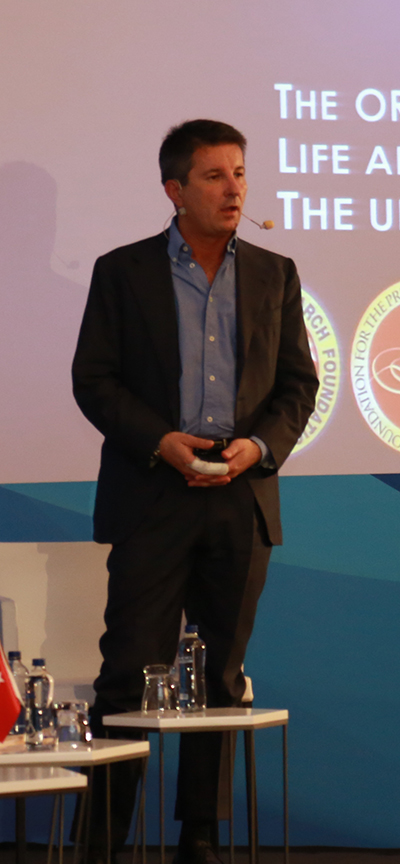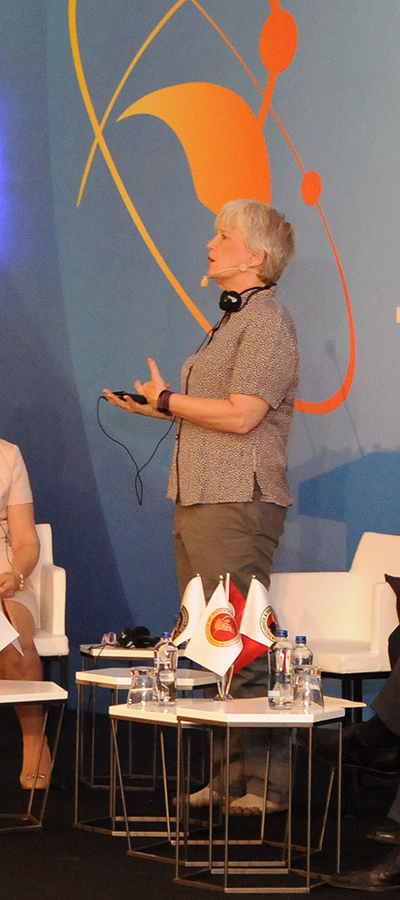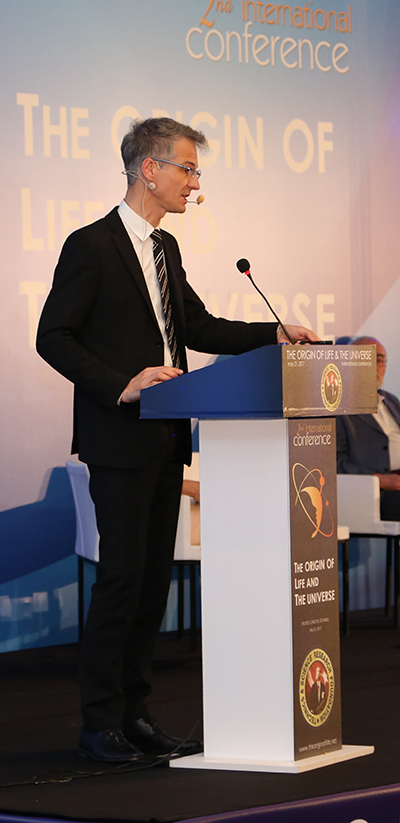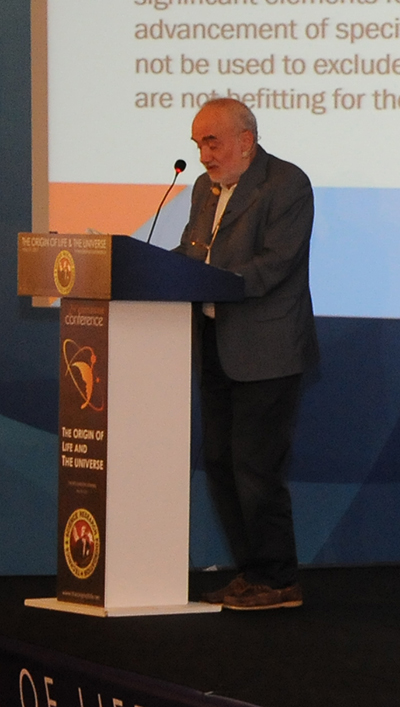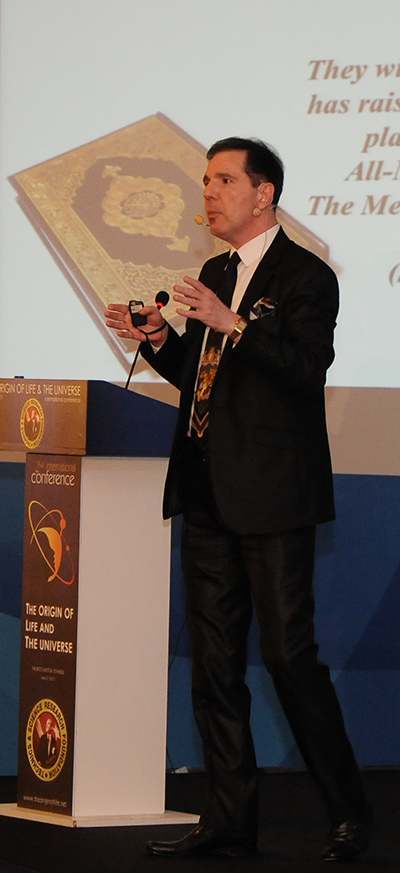Bigotry: The Dark Danger
The Origin of Life and the Universe - 2nd International Conference 2017
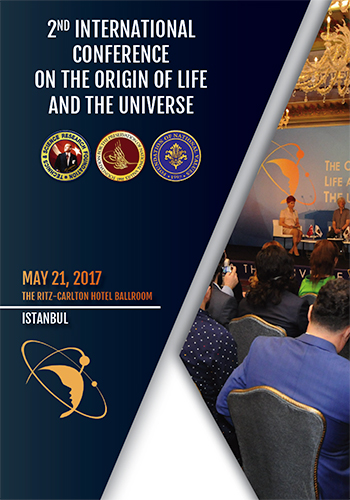
DOWNLOAD THE BOOK
CHAPTERS OF THE BOOK
- Introduction
- Conference Program
- Abstracts of Presentations
- Transcriptions of the Talks 1/8 Altuğ Berker
- Transcriptions of the Talks 2/8 Dr. Fazale Rana
- Transcriptions of the Talks 3/8 Dr. Fabrizio Fratus
- Transcriptions of the Talks 4/8 Dr. Anjeanette Roberts
- Transcriptions of the Talks 5/8 Carlo Alberto Cossano
- Transcriptions of the Talks 6/8 Dr. Paolo Cioni
- Transcriptions of the Talks 7/8 Dr. Oktar Babuna
- Transcriptions of the Talks 8/8 Jeff Gardner
- Conclusion
< <
3 / total: 12
Abstracts of PresentationsDNA’s Inspirational Design - Fazale R. Rana, PhDVice President of Research and Apologetics Reasons to Believe, Abstract
It’s exciting to be part of a project in which one of the goals is to show the world that Christians and Muslims can work together to demonstrate how scientific advance 1) points to the existence of God; and 2) undermines the evolutionary paradigm—a paradigm often used to justify atheism. If evolutionary mechanisms can account for the origin, history of life and the design of biological systems, then the obvious question arises: ‘what role is a Creator to play?” Evolutionary biologist and atheist Richard Dawkins wrote in his book the Blind Watchmaker: “Although atheism might have been logically tenable before Darwin, Darwin made it possible to be an intellectually fulfilled atheist.” Statements like this cause many people to conclude that scientific advance makes belief in God impossible. Yet, it was science that led me to the strong conviction that a Creator must exist. When I entered college, I was an agnostic. I didn’t know if God existed or not, and I honestly didn’t really care. I simply wasn’t interested in religion. the focus of my attention was biochemistry. I wanted to do everything that I could to prepare myself to go to graduate school so that I could earn a PhD in biochemistry. As an undergraduate, I was convinced that evolutionary mechanisms could account for the origin, history, and design of biological systems. My convictions were not based on a careful examination of the evidence. But instead, they were based on what my biology professors taught me. I admired my professors and because I respected them, I accepted their claims about the evolutionary paradigm without hesitation. When I speak on university campuses in the United States, I often encounter students who—as I did—uncritically embrace the evolutionary paradigm, because they, too, respect and admire their professors. But, my views changed during my graduate studies. One of the goals of a graduate education is to teach the student to independently think through the scientific evidence and develop conclusions based on the evidence alone, regardless of what other experts might say. and because I was learning to think for myself, I was willing to ask questions that I did not ask as an undergraduate student. One of those questions was: How did life originate? The elegant design, the sophistication, and the ingenuity of biochemical systems prompted me to ask that question. I wanted to know: How does the scientific community account for the origin of such remarkable biochemical systems through strictly mechanistic processes? After examining the various explanations available at that time, I was shocked. the explanations presented by the scientific community seemed to me to be woefully inadequate. I was convinced that chemical and physical processes alone could not generate life itself. This realization coupled with the elegant design and biochemical systems forced me to that conclusion– for intellectual reasons alone– that a Creator must indeed exist and must have been responsible for bringing life into being. Who is the Creator? Do I relate to the Creator? If so, how? I became convinced that the answer to these questions was found in Christianity. I reached these conclusions over 30 years ago. and in the prevailing decades, the scientific evidence has continued to confirm my convictions about God’s existence. the case that can be made for a Creator from the design of biochemical systems and the problems associated with the origin of life has become even more compelling. Towards this end, I will focus on the elegant, ingenious design of DNA and describe three ways this biomolecule’s structure and function are inspiring new nanotechnologies. Evolution: Myth or Reality? - Fabrizio FratusSociologist, Italy Abstract
Is Darwin’s theory myth or reality? to give an answer to this question we must first know if Darwinism is science. So let’s try to understand in a simple way what science is. Science must be observable, repeatable and testable. We must be able to verify that an experiment produces an effect that cannot be falsified. In this regard, it is very important to understand Karl Popper’s theory. In an attempt to epistemologically understand what Darwin’s theory was and how it has formed, Karl Popper tried to find out a proof that could confute the theory itself. At some point, Karl Popper came to the conclusion that Darwinism is not a testable theory but it is just a metaphysical research program. This means that Karl Popper, an atheist philosopher, described Darwin’s theory as a metaphysical theory that has nothing to do with science. Antonino Zichichi, president of the World Physics Association in Italy, wrote a book entitled: “Colui Che Ha Fatto Il Mondo” (The One Who Made the World) in which he explained the credibility of a scientific theory and said that the evolution of the human species remains below the level of scientific credibility because Darwin’s theory does not pass the test of reproducibility and, since it is not possible to study events that are not reproducible, it is also impossible to observe an effect that have occurred only once. So, Antonino Zichichi thinks that Darwin’s theory is not science, therefore it is not observable, it is not repeatable and not testable. This is an important point because it means that when we speak about Darwinism, we are not talking about science. Therefore, the science system must reject this hypothesis. Let’s now talk about what Darwinism produces. Let’s see the definition of the word “race” found in Italian vocabularies. a race is a human population locally or globally located, distinguished as a group more or less differentiated by genetically transmitted physical characteristics. So this is the definition of “race”. We know that anthropologists classify the four existing races in: Australians, Negroid, Mongols, and Caucasians. What does Darwinism say instead? Darwinism says that races have developed independently, and that some of them have developed better than others. This is an important point to understand. In 1833 Darwin wrote, referring to the inhabitants of Terra del Fuoco: “These were the most abject and miserable creatures I anywhere beheld. Viewing such men, one can hardly make oneself believe that they are our fellow-creatures.” In 1871, speaking about the descendants of man, he said that non-white races simply cannot elevate entirely to the level of civilized human beings, and that they are mentally and morally at a lower level, in a way they are stuck at a previous stage of the biological evolution of human species. This means that they are inferior. That’s what Darwin said. Darwinism creates racism. In Darwin’s theory, we know that nature is a continuous war for survival, a battle that every living being must constantly fight against his own kind and other species. This is the interpretation of evolutionists and not the reality. It is clear that, if man believes he descended from the primates, he will believe in values that would be different from the values he believed in if he knows that he was created by God. Darwin’s theory teaches us that man is perpetually in competition to survive and that his survival depends on his ability to choose what is best for him. Humans are not the production of chance, are not a mistake, but are desired and designed and so are all the living things on earth. the Designer cannot be other than God. Why Did God Create Viruses? - Anjeanette “AJ” Roberts, PhDResearch Scholar with Reasons to Believe (Former assistant professor of graduate education at the University of Virginia 2006-2013 and staff scientist at the National Institutes of Health, NIAID, LID 2003-2006) Abstract
When others learn I’m a virologist, they often ask, “Are viruses alive?” When they learn that I’m a Christian, they often ask, “Why would a good God create viruses?” I love to address questions like these and have spent years thinking about viruses and their roles in Creation and human sickness, and their use as tools in mitigating suffering, and more. As a Christian who is also a scientist I often use scientific discoveries to help others see how God reveals himself to us in Creation. Christian scriptures actually tell us that Creation or nature actually points people to the realization of God’s existence. But not just that, nature actually reveals God’s power and attributes to us as well. Now certainly some viruses can be very dangerous and even deadly. So the question, “Why would a good God create viruses?” is a great question! of course this question assumes that viruses are bad, causing sickness, suffering and sometimes, even death. This question though actually reveals a lack of understanding of viruses and their role in nature. Now of course we know of viruses like bird flu or fowl pox, or herpes, or measles — which kills 15 people every hour — and hemorrhagic fever viruses that can affect entire populations and cause widespread disease and mortality even on a global scale. Recent technological advances and the advent of metagenomics have changed the way we understand viruses. Scientists now have the capability to extract DNA from environmental samples and sequence multiple organisms at once. Through such analyses we now realize that Earth is filled with a truly vast array and diversity of viruses. Everywhere we find life, we find viruses. and we find them in overwhelming abundance! a single milliliter of ocean water or a gram of soil can harbor 10 — 100 million virus particles or more! Viruses outnumber all other living things by a factor of 10 to 1 or even 100 to 1 or more! Yet only an infinitesimal fraction of an infinitesimal fraction of viruses is associated with human disease, or diseases of any kind. the vast majority of viruses on planet Earth are not associated with disease or suffering. In fact they are critical for sustaining balance in Earth’s ecological webs and providing higher ordered organisms ecological space in which to thrive. If it were not for viruses, bacteria and other single-cell organisms would rule the Earth, sequestering all nutrients and filling all ecological niches, making higher life and the survival of multicellular organisms impossible. Bacteriophage also helps keep our planet’s ecological niches and our bodies’ microbiomes in balance so that we are not overrun by bacteria. Some viruses allow infected plants’ survival advantages under drought or cold temperatures that prove detrimental to un-infected plants. Viruses can also be manipulated and engineered to use in an arsenal to fight diseases. We can use viruses to fight cancers, congenital and genetic diseases, and viral and bacterial diseases according to the latest WHO targets. Viruses are now being used to fight cancers directly and as shuttles to deliver gene-editing molecules in fights against cancers such as sarcoma, melanoma and myeloma. Viruses may also be the next best weapon to fight multi-drug resistant bacteria too! Although a few viruses are remarkably bad, we cannot paint all viruses with the same brush. In fact, life as we know it would not be possible and our thriving as human beings and caretakers of Creation would be impossible without the vast array of viruses that fill the Earth. Creation’s design certainly necessitates a vast storehouse of diverse viruses for keeping life on Earth well regulated, whether in the human gut or the global biogeochemical cycles. with such an abundance of still unknown viruses, we have so much more to discover! and so many reasons to marvel at God’s amazing Creation and providence. Thanks be to God. Informatics Records and Protein Production - Carlo Alberto CossanoClinical Pathologist, Italy Abstract
We’re living in the Digital Age. It’s really hard, if not impossible, to find a process that is not in some way managed, controlled, administered or enhanced through the use of a computer program or a database or any software application. It’s normal that we have these solutions today, having reached the peak of the information age, thanks to decades of enhancements applied by intelligent beings with that specific purpose, so what we have is the best of what intellectual and technological growth can develop in years and years. But it may seem less “normal” to find out that these very same logics and considerations, that we’ve just described as the product of years and years of applications by the most clever being of the planet, are fully adopted in biological processes operating in the cells inside our body, as in those of every living organism. And this happens since the appearance of the first unicellular life forms, with logics and processes fundamentally unchanged from the extant ones. Proteins aren’t “substances”, as how sometimes are simplistically defined; granted, from a certain point of view everything is a “substance”, even the computer that we use when we surf the Internet, since substances are constituted by atoms, and atoms are the fundamental building blocks of matter. Proteins are rather electrochemical mechanical (and, as we will see, even information processing) mechanisms that constitute, assemble, regulate, maintain, manage, transform create and destroy (and much more) cells and tissues of any living or- ganism (and even of any “non-living” one, like viruses). Their almost boundless diversity is remarkable: it’s been estimated that inside of the human body there are at least 25.000 different kind of proteins, every one with its specificity that can be connected to a moment, a purpose, a quantity essential or concurrent to the completion of a certain function. What prepares and produces proteins in the cell? Very simple: other proteins, themselves prepared and produced in the same way. But, if we make an analogy, it will be easy to grasp that for a production line that must continue according to specific and highly variable requirements with 25.000 different pieces, you need to manage the production flow, in some way. The amount and diversity are so high that a “production problem” in such a “factory” would mean not only a halt in the production line, with a following money loss, but the very same, cost the life of the cell and maybe of the entire organism. It becomes clear that it’s essential to have the pieces production line under control, managing the different phases, maybe having the information of the point at which the single piece is in the production phase: a state management. It is incredible that the solutions used by informatics today, which resulted from decades of enhanced applied intelligence, and ideas of competent intelligent human beings, is exactly what is happening inside the cell. Psyche and the Crisis of Materialist Reductionism - Paolo Cioni, PhDPsychiatrist, Italy Abstract
Increasingly hard times are ahead for pure materialists. Famous neuroscientist C. Koch, who has worked for 20 years with F. Crick, codiscoverer of the DNA molecule, has recently (2009) shocked the scientific community by publishing his belief that consciousness probably does not reside exclusively in the brain, but it is an essential manifestation of reality. This view, known by philosophers as “panpsychism”, today finds its highest expression in the scientific theory of consciousness of neuroscientist G. Tononi, in the past collaborator of super materialist G. M. Edelmann, Nobel Prize winner, and cowriter of the book: A Universe of Consciousness, How Matter Becomes Imagination” in 2000. Tononi has outlined in 2004, and then developed later, the so-called ITT (Integrated Information Theory). According to this perspective, “consciousness is a fundamental property, such as mass and charge. Wherever there is an entity with multiple states, there is some consciousness. a special structure (like human nervous system) is needed to gather much of it, but consciousness is everywhere, it is a fundamental property.” This theory, so distant from the initial purely materialistic mainstream approach, is now subject to serious consideration by the neuroscience world, being based on empirically quantifiable assumptions. the implications are vast, and unthinkable until today: the mathematical value of the information integrated into a network, known as Phi, is greater than zero in every living cell, each electronic circuit, even in a proton consisting of only three elementary particles. Physicists like J. Wheeler have laid the foundation for an understanding of a completely new reality, in which matter, laws and physical constants of nature, and the whole universe are best described, not in terms of physical objects, but through ‘”processing of a fundamental dynamic information”. Quantum mechanics suggests that at the deepest level of nature, the entire physical universe is interconnected. Could the total information of the Universe be integrated in some deep sense? Is the Universe in some way conscious of itself? Are we ourselves, with our separate and cooperative individual consciences the way in which the Universe is conscious of itself? Mystery and awe are part of our lives and accompany us through all our transformative experiences. Materialistic reductionism only distances us from the truth. Picture Christians Project - Jeff GardnerFounder of the Picture Christians Project, USA Abstract
Representatives of such different faiths, some, even, that the world would assume could not come together as we have. This in itself is an accomplishment worthy of note. We are here because despite our differences as Muslims, Christians and Jews, we all share, we all face, a common enemy secularism, atheism and violent ideologies. the first two secularism and atheism, are the most pervasive and thus more problematic. Secularism and atheism share a common tactic in their attempts to silence those that they disagree with they work constantly at making their opponents disappear. How do you make someone or someones disappear in the 21st century? It does not involve a magical formula. No, it is as simple as not showing or discussing them, that is, not allowing them to be heard or seen, especially in public. Out of sight is truly out of mind and secularists and atheists know this. If we look back to the book of Genesis, that account of God’s relationship to Creation and humanity, we find that after forming humankind, God breathed life into us an intimate communication with us, an intimate connection with us. Secularists and atheists attack this connection between humanity and the Divine, not only by denying that it exists, but by refusing to even discuss the matter, in word and especially image. Concerning struggle with secularism and atheism, our challenge is twofold. First we must continue to formulate sound, rational arguments concerning the origins of life. Second – we must better understand and utilize the means of communication to deliver the message. In this instance, communicating the message, the challenge is the opportunity. Communication in the 21st century is a moving target, a rapidly developing mix of electronic, socalled conventual and tried and true interpersonal methods of connecting and communicating, a mix that welcomes innovation and is often forgiving of mistakes. We should embrace this opportunity along with its challenges. The Collapse of the Theory of Evolution and the Fact of Creation - Oktar Babuna, MDNeurosurgeon, Istanbul, Turkey Abstract
The subject of this presentation reveals a crucial secret of your life. the content of this presentation presents not just a different approach, or a philosophical thought: it is a fact, which is also proven by science today. Man is conditioned right from the beginning of his life, that the world he lives in has an absolute material reality. So he grows up under the effect of this conditioning and builds his entire life on this viewpoint. the findings of present-day science, however, have revealed a completely different and significant reality than what is presumed. All the information that we have about the external world is conveyed to us by our five senses. the world we know of consists of what our eyes see, our ears hear, our noses smell, our tongues taste, and our hands feel. Man is dependent on only those five senses since birth. That is why he knows the “external world” only the way it is presented by these senses. Yet, scientific research carried out on our senses has revealed very different facts about what we call the “external world”. and these facts have brought to light a very important secret about matter, which makes up the external world. In order to better grasp this secret behind matter, let us be reminded of our information about our “sense of sight” which provides us with the most extensive information about the external world. The act of seeing is realized progressively. At the instance of seeing, light clusters called photons travel from the object to the eye and pass through the eye lens where they are refracted and focus on the retina at the back of the eye. Here, rays are turned into electrical signals and then transmitted by neurons to the center of vision at the back of the brain. the act of seeing actually takes place in this center in the brain. All the images we view in our lives and all the events we experience are actually experienced in this tiny and dark place. Now, let us reconsider this information more carefully. When we say, “we see”, we actually see the “effect” the rays reaching our eyes form in our brain by being converted into electrical signals. When we say, “we see”, we actually observe the electrical signals in our brain. We can explain this interesting situation with an example: Let us suppose that in front of us there is a burning candle and we view its light. During this period when we view the candle’s light, the inside of our skull and our brain are in absolute darkness. the light of the candle never illuminates our brain and our center of vision. However, we watch a colorful and bright world inside our dark brain. The same situation applies to all our other senses. Sound, touch, taste and smell are all perceived in the brain as electrical signals. Therefore, our brains, throughout our lives, do not confront the “original” of the matter existing outside us, but rather an electrical copy of it formed inside our brain. It is at this point that we are misled by assuming these copies are instances of real matter outside us.
|
3 / total 12
You can read Harun Yahya's book The Origin of Life and the Universe - 2nd International Conference 2017 online, share it on social networks such as Facebook and Twitter, download it to your computer, use it in your homework and theses, and publish, copy or reproduce it on your own web sites or blogs without paying any copyright fee, so long as you acknowledge this site as the reference.

